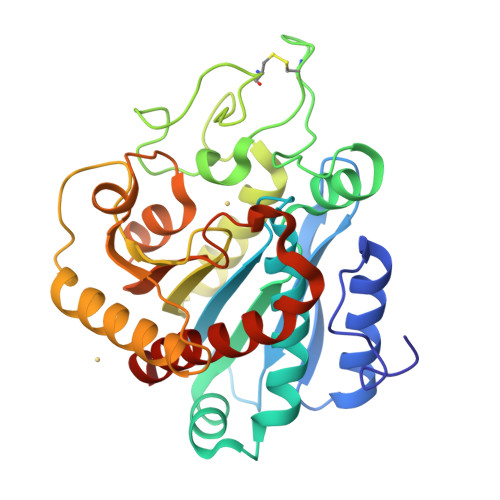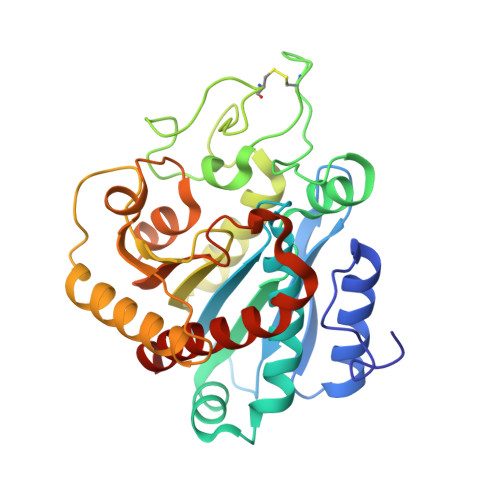Three high-resolution crystal structures of cadmium-substituted carboxypeptidase A provide insight into the enzymatic function
Jensen, F., Bukrinsky, T., Bjerrum, J., Larsen, S.(2002) J Biol Inorg Chem 7: 490-499
- PubMed: 11941507
- DOI: https://doi.org/10.1007/s00775-001-0324-0
- Primary Citation of Related Structures:
1EE3, 1ELL, 1ELM - PubMed Abstract:
Three high-resolution crystal structures of Cd(II)-substituted carboxypeptidase A (CPA) have been determined by X-ray diffraction from crystals prepared in three different buffer systems to assess the effect of pH and ionic strength on the Cd(II) coordination geometry. All crystallize in the space group P2(1) with identical cell dimensions. Cd-CPA(7.5): Cd(II)-substituted CPA prepared at pH 7.5 with [Cl(-)]=2 mM determined to 1.70 A resolution ( R=17.4% and R(free)=19.8%); Cd-CPA(5.5): Cd(II)-substituted CPA prepared at pH 5.5 with [Cl(-)]=2 mM to 2.00 A resolution ( R=16.1% and R(free)=18.6%); Cd-CPA(7.5)-Cl: Cd(II)-substituted CPA prepared at pH 7.5 with [Cl(-)]=250 mM to 1.76 A resolution ( R=16.7% and R(free)=17.8%). No noticeable structural changes were observed between the three structures. Two water molecules coordinate to Cd(II), in contrast to the single water molecule coordinating to Zn(II) in the Zn-CPA structure. No binding sites for anions could be identified, even in the structure with a high concentration of chloride ions. It is suggested that the anion inhibition is due to weak outer-sphere association of Cl(-) ions at several binding sites, shielding the strong positive charge distribution at the surface of the protein near the active site. Based on structural data and a sequence alignment of 18 non-redundant carboxypeptidases, a more elaborate version of the earlier reaction model is proposed that also addresses the transport of water to and from the active site. Conserved residues whose function was not addressed previously delineate the proposed pathways used in the transport of water during catalysis.
Organizational Affiliation:
Centre for Crystallographic Studies, Department of Chemistry, University of Copenhagen, Universitetsparken 5, 2100 Copenhagen, Denmark.



















